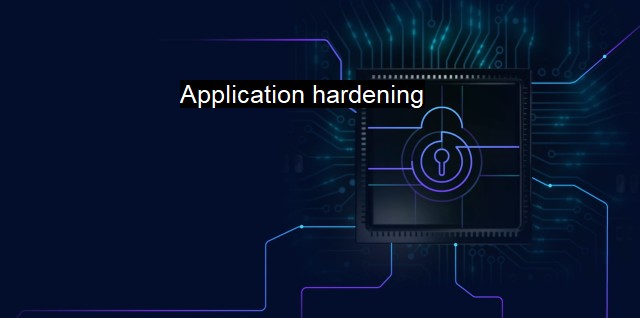What is Application hardening?
Securing Your Software Applications: The Importance of Application Hardening in Cybersecurity Defense
Application hardening is a critical aspect of cybersecurity, directly connected with cutting-edge protocols for anti-malware and antivirus protection. It refers to the process of augmenting security measures to make applications less vulnerable to potential threats by reducing the attack surface. It's essentially about securing an application by reducing its susceptibility to intrusions from unauthorized users, malwares or external malevolent attacks.When we speak about hardening a system, we often refer to the narrowing of possible attack vectors. The same concept applies to application hardening. It minimizes the attack surface of the applications making them less prone to exploitation by potential security threats. These potential threats include hackers who may manipulate the vulnerabilities in the system, manipulate its functionalities, or misuse the initial coding to inject malicious software that can bring down the entire system.
The strategy behind application hardening is founded on two critical principles. The first being the concept of providing the least privilege, and the second being, to lessen attack surfaces. Providing the least privilege means that an application or process should only have the minimum permissions essential to function correctly. On the other hand, decreasing attack surfaces refers to limiting the number of areas or points that can be potentially attacked or compromised.
It's significant to note that the software code forms the backbone for application hardening. Consequently, security should be a vital consideration for developers, right from the software development phase to the deployment stage. Developers should ensure that they follow secure coding practices for reducing the likelihood of vulnerabilities in the code, which can be exploited later. it is important to carry out audits on a regular basis to identify code deficiencies that may pose a threat. Patching these deficiencies is as essential, since unattended vulnerabilities can be manipulated by hackers to their advantage.
Another aspect of application hardening process includes the configuration of security. Misconfigured applications often expose systems to a breach. Therefore, there should be a regulatory control on configuration settings to increase the robustness of applications against cyber threats.
In the realm of antivirus protection, application hardening plays a vital role. Antiviruses work efficiently when they are complemented with hardening techniques that add layers of security to create a more resilient system. Various techniques such as system hardening, sandboxing, and runtime application self-protection (RASP) can assist in the fortification of antivirus protection programs.
Sensitive data protection is another crucial aspect of application hardening. Implementing robust encryption is important to safeguard confidential data against security breaches. In many cases, businesses use an approach called obfuscation to increase difficulty for hackers in understanding the code or the system.
Lastly, conducting periodic assessments is part and parcel of application hardening. Penetration testing and security evaluations should be conducted on regular intervals to identify vulnerabilities resting in the system that could be a potential access point for threats.
Application hardening is integral to cybersecurity, particularly when taken in the context of antivirus protection. While seemingly a daunting task, it is indispensable in the contemporary tech-sphere where cybersecurity threats are constantly evolving. Utilizing a multi-layered security approach rooted in the strategic principles of limiting access and lessening attack surfaces can significantly enhance the resilience of an application. Incorporating this strategy from the early stages of software development, and continuously maintaining and testing its efficiency, contributes immensely to the overall strength and security of applications against potential threats.

Application hardening FAQs
What is application hardening in cybersecurity?
Application hardening is the process of improving the security of software applications by reducing their attack surface, increasing their resistance to attacks, and detecting and responding to security incidents in a timely manner. It involves several techniques such as code obfuscation, anti-tampering, encryption, and runtime application self-protection.Why is application hardening important for antivirus software?
Antivirus software relies on the ability to detect and stop malicious code from executing on a computer. Application hardening can make it more difficult for attackers to create and execute malware by making it harder to reverse-engineer, modify or exploit the software’s vulnerabilities. By hardening antivirus software applications, the likelihood of a successful attack is reduced, which can significantly enhance the overall security posture of an organization.What are some common techniques used in application hardening?
Some common techniques used in application hardening include code obfuscation, anti-tampering, encryption, anti-debugging, and runtime application self-protection (RASP). Code obfuscation makes it difficult to reverse-engineer the code, anti-tampering techniques protect against modification of the application, encryption makes it harder to extract sensitive data or code, anti-debugging makes it more difficult to debug or analyze the application, and RASP provides continuous monitoring and protection of the application during its execution.How can organizations implement application hardening in their cybersecurity strategy?
Organizations can implement application hardening by using specialized tools that automate the process, working with vendors who provide software with built-in hardening features, and adopting secure coding practices. They can also perform regular security assessments to identify vulnerabilities and prioritize hardening efforts based on risk assessment. Additionally, organizations should ensure that their employees are trained in secure coding practices and understand the importance of application hardening in protecting against cyber threats.| | A | | | B | | | C | | | D | | | E | | | F | | | G | | | H | | | I | | | J | | | K | | | L | | | M | |
| | N | | | O | | | P | | | Q | | | R | | | S | | | T | | | U | | | V | | | W | | | X | | | Y | | | Z | |
| | 1 | | | 2 | | | 3 | | | 4 | | | 7 | | | 8 | | |||||||